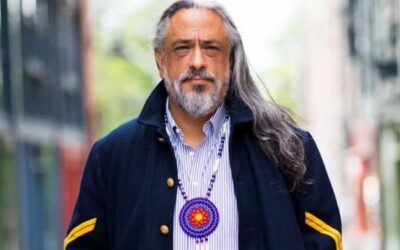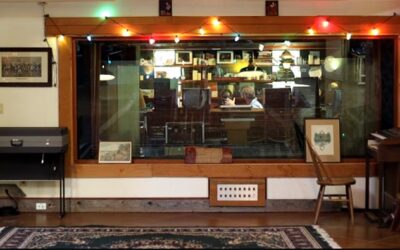This spring, Town Hall is thrilled to welcome performance and visual artist Timothy White Eagle as our Artist-in-Residence. He has worked extensively over the past two decades exploring Native American, Pagan, and other earth-based spiritual practices. This will be a continued focus during his residency, as he interrogates the differences between early Indigenous peoples’ handling of death and the Christian colonizer approach to death, a topic that has been heavy on his mind in the time of COVID.
Fermata | Bear Creek Recording Session Behind the Scenes
My friend Hayley Young was moved by a piece I wrote recently – one of the more hopeful works from the Musical Journal I was commissioned to create in response to the pandemic. It’s a piece that came to me during a big road trip through the Western United States, and I immediately felt compelled to send this music to people that I thought might need a moment of hope. That’s a little unusual for me; I’m often self-conscious about what I write and hesitant to share. In this instance, though, I felt that the music that I created was something I very much needed to not only write, but to hear – and that others might have that same need.
Hayley immediately called me after listening to it with the idea to bring producer Ryan Hadlock on board, go to his Recording Studio and not only record the piece, but document the process for a special project she’s working on. She brought Alex Crook to run cameras and along with Ryan’s engineer Taylor Carroll we spent three days setting up, recording, and mixing the track, capturing everything on video along the way.
Fermata | Widespread Orchestra Feature Release
The idea for a Widespread Orchestra began as a poem by Mighty Mike McGee. It begins “Today, I dance knowing / someone somewhere dances with me” and San Jose-based composer Noah Luna was inspired to write a piece where people could come together, despite their physical isolation. He began work on a composition for chorus and cello and partnered with Joshua Roman as part of his Fermata residency, here at Town Hall to produce the project.
In October, dozens of singers sent us their voices (and some even sent videos) to bring to life Noah’s vision, alongside Town Hall’s very own Joshua Roman on the cello.
Watch the final product below!
Listening Guide: In The Moment Ep. 37
In episode #37 of In The Moment, Chief Correspondent Steve Scher talked with Alva Noë about the philosophy of baseball.
Host Jini Palmer talked with Edward Wolcher and Megan Castillo, Town Hall’s Curator of Lectures and Community Engagement Manager, about our upcoming Homecoming festival in September.
Listening Guide: In The Moment Ep. 36
In episode #36 of In The Moment, Correspondent Grace Madigan sits down with Ed Levine (3:33) to explore his journey and the inspirations that led him to create his food blog Serious Eats. Levine...
Listening Guide: In The Moment Ep. 34
This listening guide is a two-parter! In episode #34 of In The Moment, Chief Correspondent Steve talks with Rachel Louise Snyder (5:25), host Jini Palmer covers a conversation between Executive Director Wier Harman and Town Hall founder David Brewster (15:51) and correspondent Charles Cross talks with John Waters (1:08) about his transgressive movies, living with stars, and some shared moments in Seattle. Waters reflects on what he’s learned along the way and where he’s going now.
Listening Guide: In The Moment Ep. 30
In episode #30 of In The Moment, correspondent and Grist editor Matt Craft sat down with journalist Dahr Jamail (2:17), Chief Correspondent Steve Scher interviews Siri Hustvedt (12:28), and host Jini Palmer highlights a theatrical radio performance from the Mahogany Project for the 13th annual Urban Poverty Forum (24:16).
Listening Guide: In The Moment Ep. 29
In episode #29 of In The Moment, correspondent Katy Sewall talks with John Lanchester (3:58) about his book The Wall. They delve into Lanchester's inspiration for the book—a recurring dream....
Listening Guide: In The Moment Bonus Episode (Global Rhythms)
In this bonus episode of In The Moment, get an inside look at the past and present of our Global Rhythms series! Host Jini Palmer talks with Spider Kedelsky, the founder of the Global Rhythms...


